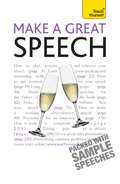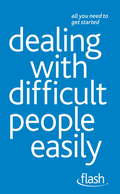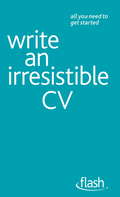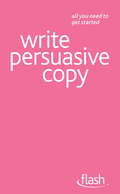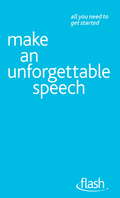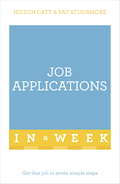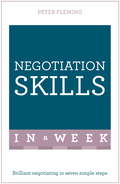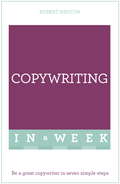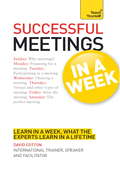- Table View
- List View
Make a Great Speech: Teach Yourself (Teach Yourself General)
by Jackie ArnoldWritten by a professional toastmaster, keynote speaker and voice coach, this book gives you all you need to make an effective speech on any occasion. From weddings and christenings to fundraising events and after-dinner speeches, it offers suitable material for any occasion, with practical techniques and strategies for everything from using props to conquering stage fright and banishing your butterflies forever. Teach Yourself - the world's leading learning brand - is relaunched in 2010 as a multi-platform experience that will keep you motivated to achieve your goals. Let our expert author guide you through this brand new edition, with personal insights, tips, energising self-tests and summaries throughout the book. Go online at www.teachyourself.com for tests, extension articles and a vibrant community of like-minded learners. And if you don't have much time, don't worry - every book gives you 1, 5 and 10-minute bites of learning to get you started. - Gives you a comprehensive source of advice, material and techniques for wedding speeches - Offers hints on how to speak effectively and conquer your butterflies - Features practical guides to making the most of props and technology
Dealing with Difficult People Easily: Flash
by Karen ManneringThe books in this bite-sized new series contain no complicated techniques or tricky materials, making them ideal for the busy, the time-pressured or the merely curious. In just 96 pages, Dealing with Difficult People Easliy shows you how to deal with an unpleasant but unavoidable aspect of working life that can have a major impact on your career and wellbeing, including knowing how to define and deal with a difficult person in any work relationship and how to understand yourself and deal with difficult aspects of your own personality.
Dealing with Difficult People Easily: Flash
by Karen ManneringThe books in this bite-sized new series contain no complicated techniques or tricky materials, making them ideal for the busy, the time-pressured or the merely curious. In just 96 pages, Dealing with Difficult People Easliy shows you how to deal with an unpleasant but unavoidable aspect of working life that can have a major impact on your career and wellbeing, including knowing how to define and deal with a difficult person in any work relationship and how to understand yourself and deal with difficult aspects of your own personality.
Write an Irresistible CV: Flash
by Julie GrayThe books in this bite-sized new series contain no complicated techniques or tricky materials, making them ideal for the busy, the time-pressured or the merely curious. Write an Irresistible CV helps you to write and refine a CV that communicates who you are and shows off your skills, talents and all you have to offer.
Write an Irresistible CV: Flash
by Julie GrayThe books in this bite-sized new series contain no complicated techniques or tricky materials, making them ideal for the busy, the time-pressured or the merely curious. Write an Irresistible CV helps you to write and refine a CV that communicates who you are and shows off your skills, talents and all you have to offer.
Write Persuasive Copy: Flash
by Jonathan GabayThe books in this bite-sized new series contain no complicated techniques or tricky materials, making them ideal for the busy, the time-pressured or the merely curious. Write Persuasive Copy helps you to write compelling copy, to show off your communication skills and fulfil your creative potential.
Make an Unforgettable Speech: Flash
by Jackie ArnoldThe books in this bite-sized new series contain no complicated techniques or tricky materials, making them ideal for the busy, the time-pressured or the merely curious. Made An Unforgettable Speech is a short, simple and to-the-point guide to learning the basic principles of a great speech in a few short steps. Whether for a wedding, a presentation or just a special occasion, in just 96 pages you will discover how to master the essential ideas and deliver a captivating and memorable performance, helping you to make a lasting impression with no effort at all.
Make An Unforgettable Speech: Flash
by Jackie ArnoldThe books in this bite-sized new series contain no complicated techniques or tricky materials, making them ideal for the busy, the time-pressured or the merely curious. Made An Unforgettable Speech is a short, simple and to-the-point guide to learning the basic principles of a great speech in a few short steps. Whether for a wedding, a presentation or just a special occasion, in just 96 pages you will discover how to master the essential ideas and deliver a captivating and memorable performance, helping you to make a lasting impression with no effort at all.
Win The Job You Want: Flash
by Roderic AshleyThe books in this bite-sized new series contain no complicated techniques or tricky materials, making them ideal for the busy, the time-pressured or the merely curious. Win The Job You Want helps you to become a hot property in today's competitive job market. It will help you to understand yourself and show you how to not get just any old job but to improve your chance of a truly fulfilling career.
Win The Job You Want: Flash
by Roderic AshleyThe books in this bite-sized new series contain no complicated techniques or tricky materials, making them ideal for the busy, the time-pressured or the merely curious. Win The Job You Want helps you to become a hot property in today's competitive job market. It will help you to understand yourself and show you how to not get just any old job but to improve your chance of a truly fulfilling career.
Teambuilding: Bullet Guides
by Mac BrideAre you looking for a complete course in Dutch which takes you effortlessly from beginner to confident speaker? Whether you are starting from scratch, or are just out of practice, Complete Dutch will guarantee success!
Copywriting: Bullet Guides
by Tina KonstantOpen this book and you will Compose great copy Engage your audience Persuade brilliantly Build sales
Copywriting: Bullet Guides
by Tina KonstantOpen this book and you will Compose great copy Engage your audience Persuade brilliantly Build sales
Great PR: Bullet Guides
by Brian SalterWhat's in this book?Open this book and you will... - Improve communication - Foster development - Establish goals - Encourage successLearn how to be a mentor:- Understanding mentoring- The mentoring process- Successful mentoring relationships- Skills for successful mentors and mentees- Common pitfalls- The benefits of mentoring- Advice about giving advice- Bringing it to a successful closeSample page spread: What are Bullet Guides?The answers you need - now.Clear and concise guides in a portable format. Information is displayed in an easy-to-read layout with helpful images and tables. Bullet Guides include all you need to know about a subject in a nutshell. Get right to the point without wading through loads of unnecessary information.
Great PR: Bullet Guides
by Brian SalterWhat's in this book?Open this book and you will... - Improve communication - Foster development - Establish goals - Encourage successLearn how to be a mentor:- Understanding mentoring- The mentoring process- Successful mentoring relationships- Skills for successful mentors and mentees- Common pitfalls- The benefits of mentoring- Advice about giving advice- Bringing it to a successful closeSample page spread:What are Bullet Guides?The answers you need - now.Clear and concise guides in a portable format. Information is displayed in an easy-to-read layout with helpful images and tables. Bullet Guides include all you need to know about a subject in a nutshell. Get right to the point without wading through loads of unnecessary information.
Presenting: Bullet Guides
by Mo ShapiroWhat's in this book?Open this book and you will... - Improve communication - Foster development - Establish goals - Encourage successLearn how to be a mentor:- Understanding mentoring- The mentoring process- Successful mentoring relationships- Skills for successful mentors and mentees- Common pitfalls- The benefits of mentoring- Advice about giving advice- Bringing it to a successful closeSample page spread: What are Bullet Guides?The answers you need - now.Clear and concise guides in a portable format. Information is displayed in an easy-to-read layout with helpful images and tables. Bullet Guides include all you need to know about a subject in a nutshell. Get right to the point without wading through loads of unnecessary information.
Job Applications In A Week: Get That Job In Seven Simple Steps
by Hilton Catt Patricia ScudamoreGetting hired just got easierYou are about to discover everything you need to know about job applications and how to make them work. Starting on Sunday and going through to Saturday, you will learn the stages of a job application step by step so you build up a picture of what it takes to be successful. For many job applicants, what goes on behind employers' closed doors remains a hidden world but, by Saturday, you will have taught yourself how job applications are processed, what employers look for when they make up interview lists, and then, from the candidates they interview, who to shortlist and who to offer the job to.After considering what employers want and how you could meet their needs you will be able to formulate a plan for what needs to go into your CV, what you need to put in your cover letters and what you need to say about yourself on application forms. You will discover how to measure up the competition and how to make sure your name, and not someone else's, is on the interview list.You will also discover the importance of getting the right messages across in interviews - and what the right messages are. You will learn how to dictate the interview agenda to keep it on familiar territory where the best parts of your application will come out. You will learn to handle tough interview questions and to see what's behind them and what answers will impress the interviewer most. Once you've been shortlisted, you'll discover how to steer your application over the last hurdle and get the job offer you want.- Sunday: Defining the task- Monday: You and the image you present- Tuesday: Selection criteria- Wednesday: Getting interviews- Thursday: Going for interviews- Friday: Handling questions- Saturday: Getting shortlisted
Job Applications In A Week: Get That Job In Seven Simple Steps
by Pat Scudamore Hilton CattGetting hired just got easierYou are about to discover everything you need to know about job applications and how to make them work. Starting on Sunday and going through to Saturday, you will learn the stages of a job application step by step so you build up a picture of what it takes to be successful. For many job applicants, what goes on behind employers' closed doors remains a hidden world but, by Saturday, you will have taught yourself how job applications are processed, what employers look for when they make up interview lists, and then, from the candidates they interview, who to shortlist and who to offer the job to.After considering what employers want and how you could meet their needs you will be able to formulate a plan for what needs to go into your CV, what you need to put in your cover letters and what you need to say about yourself on application forms. You will discover how to measure up the competition and how to make sure your name, and not someone else's, is on the interview list.You will also discover the importance of getting the right messages across in interviews - and what the right messages are. You will learn how to dictate the interview agenda to keep it on familiar territory where the best parts of your application will come out. You will learn to handle tough interview questions and to see what's behind them and what answers will impress the interviewer most. Once you've been shortlisted, you'll discover how to steer your application over the last hurdle and get the job offer you want.- Sunday: Defining the task- Monday: You and the image you present- Tuesday: Selection criteria- Wednesday: Getting interviews- Thursday: Going for interviews- Friday: Handling questions- Saturday: Getting shortlisted
Negotiation Skills In A Week: Brilliant Negotiating In Seven Simple Steps
by Peter FlemingEffective negotiation skills just got easierThere was a time, not that long ago, when negotiation was seen, in the main, as the province of industrial relations folk and car-sales advisers. But, no longer! Repeated financial crises have squeezed profit margins and, in some markets, discouraged buyers from making marginal purchases or continuing habitual expenditure. Managers have found themselves in the frontline of the expectation to achieve better value for money, and the starting point for this is to shop around and explore the offers made by new suppliers, and/or to negotiate better deals with existing suppliers.Even if your job doesn't involve negotiation, then you might still be an active negotiator when replacing your car, moving house or even selling last season's wardrobe! The truth is that being a good negotiator has become a life skill, enabling those who are good at it not just to save money, but also to upgrade their computer, television or lawnmower with little or no increase in outgoings - and enhancing their reputation in the process.Becoming an effective negotiator is certainly within the scope of the majority of people. At its simplest, it involves thinking out what you want, planning how you'd like to get it and developing your powers of persuasion to convince other people that you are simply being reasonable.This book will help you to plan to become a better negotiator through being better prepared for meetings, planning clear and realistic objectives for a negotiation, maintaining concentration and making logical proposals that create agreement in the other party.- Sunday: Creating the right environment- Monday: Researching your objectives - Tuesday: People and places - Wednesday: Breaking the ice - Thursday: The agenda - Friday: Concluding- Saturday: Learning from your experiences
Copywriting In A Week: Be A Great Copywriter In Seven Simple Steps
by Robert AshtonThe ability to write great copy is crucial to anyone who wants to advance their career.Written by Robert Ashton, a leading expert on copywriting as both a coach and a practitioner, this book quickly teaches you the insider secrets you need to know to in order to write brilliant copy.The highly motivational 'in a week' structure of the book provides seven straightforward chapters explaining the key points, and at the end there are optional questions to ensure you have taken it all in. There are also cartoons and diagrams throughout, to help make this book a more enjoyable and effective learning experience.So what are you waiting for? Let this book put you on the fast track to success!
Copywriting In A Week: Be A Great Copywriter In Seven Simple Steps
by Robert Ashton Rob AshtonGreat copywriting just got easierIt's strange to think that there was a time when only the privileged few could read or write. The rest of us relied on the spoken word. Storytelling was used to pass knowledge on from one generation to the next. Now, most of us are literate and use the written word to gather information and inform our decision making. Increasingly we do this online, with social media and messaging enabling rapid, spontaneous global communication. But rather than freeing us from the need for clear, effective written communication, it actually makes good communication even more important. The less we communicate face to face, the greater the opportunity for misunderstandings. Of course, all writing communicates your message to people you cannot see and may never meet. It means you can influence more widely; it also means you must take care not to make assumptions aboutyour reader, especially those who see your public postings. Successful copywriting is constructed from carefully selected words, each with a clear purpose. It is written to prompt feelings, thoughts or actions. It is clear, concise and at times comforting. It is also comprehensible, even to those not yet confident users of your language. Reading this book, and following the techniques it introduces, will make you a more effective writer. Expertise in grammar is not needed as all the necessary jargon is simply defined and, anyway, some forms of business writing deliberately ignorerules. This book is for people who want to write for results. Each of the seven chapters in Copywriting In A Week covers a different aspect:- Sunday: Focusing your message- Monday: Using layout, pictures and colour to make words memorable- Tuesday: Writing effective letters- Wednesday: Making advertising work for you- Thursday: Communicating clearly with the media- Friday: Preparing promotional print- Saturday: Composing proposals and presentation visuals
Successful Meetings in a Week: Teach Yourself
by David CottonThe ability to hold successful meetings is crucial to anyone who wants to advance their career.Written by David Cotton, a leading expert on meetings as both a coach and practitioner, this book quickly teaches you the insider secrets you need to know to in order to run successful meetings.The highly motivational 'in a week' structure of the book provides seven straightforward chapters explaining the key points, and at the end there are optional questions to ensure you have taken it all in. There are also cartoons and diagrams throughout, to help make this book a more enjoyable and effective learning experience.So what are you waiting for? Let this book put you on the fast track to success!
Successful Meetings in a Week: Teach Yourself
by David CottonThe ability to hold successful meetings is crucial to anyone who wants to advance their career.Written by David Cotton, a leading expert on meetings as both a coach and practitioner, this book quickly teaches you the insider secrets you need to know to in order to run successful meetings.The highly motivational 'in a week' structure of the book provides seven straightforward chapters explaining the key points, and at the end there are optional questions to ensure you have taken it all in. There are also cartoons and diagrams throughout, to help make this book a more enjoyable and effective learning experience.So what are you waiting for? Let this book put you on the fast track to success!
CVs in a Week: How to Write a CV or Resume in Seven Simple Steps
by David Mcwhir<p>The ability to write the perfect CV for a job is crucial to anyone who wants to advance their career. <p>Written by David McWhir, a leading expert on CVs as both a recruiter and a coach for candidates, this book quickly teaches you the insider secrets you need to know to in order write the CV that will get you the job you want. <p>The highly motivational 'in a week' structure of the book provides seven straightforward chapters explaining the key points, and at the end there are optional questions to ensure you have taken it all in. There are also cartoons and diagrams throughout, to help make this book a more enjoyable and effective learning experience. <p>So what are you waiting for? Let this book put you on the fast track to success!</p>
CVs In A Week: How To Write A CV Or Résumé In Seven Simple Steps
by David McWhirThe ability to write the perfect CV for a job is crucial to anyone who wants to advance their career.Written by David McWhir, a leading expert on CVs as both a recruiter and a coach for candidates, this book quickly teaches you the insider secrets you need to know to in order write the CV that will get you the job you want.The highly motivational 'in a week' structure of the book provides seven straightforward chapters explaining the key points, and at the end there are optional questions to ensure you have taken it all in. There are also cartoons and diagrams throughout, to help make this book a more enjoyable and effective learning experience.So what are you waiting for? Let this book put you on the fast track to success!
